We asked Francesco Regazzoni to tell us about iHEART, a Horizon 2020 project, and how the team led by Prof. Alfio Quarteroni is developing a virtual heart, made up of mathematical equations that describe the complex interaction of physical phenomena that underpin the heartbeat itself. The aim is to construct a ‘digital twin’ of the patient – a virtual replica of an individual’s heart, based on their biometric data and diagnostic tests. This would prove to be a fundamental tool for heart surgeons and cardiologists, who could use it to explore different treatment options or surgical strategies before treating the actual patient, thus optimising and personalising their care based on the individual characteristics specific to them.
The name of your project speaks for itself. You’re dealing with the heart. But how, exactly? What is the concrete goal of iHEART?
The goal of iHEART is to construct a mathematical model of the human heart, i.e. a virtual replica of the organ that allows us to study and predict its behaviour by means of computer simulations. In order to build a model of this kind, we are seeking out mathematical equations capable of faithfully representing the behaviour of the heart, from the scale of the cells all the way up to that of the atria and ventricles. This results in a system of equations, all of which are paired together according to a dense network of interactions. We use specific, computer-implemented algorithms for these highly complex equations, allowing us to find an approximate – yet nonetheless very precise – solution to the issue at hand.
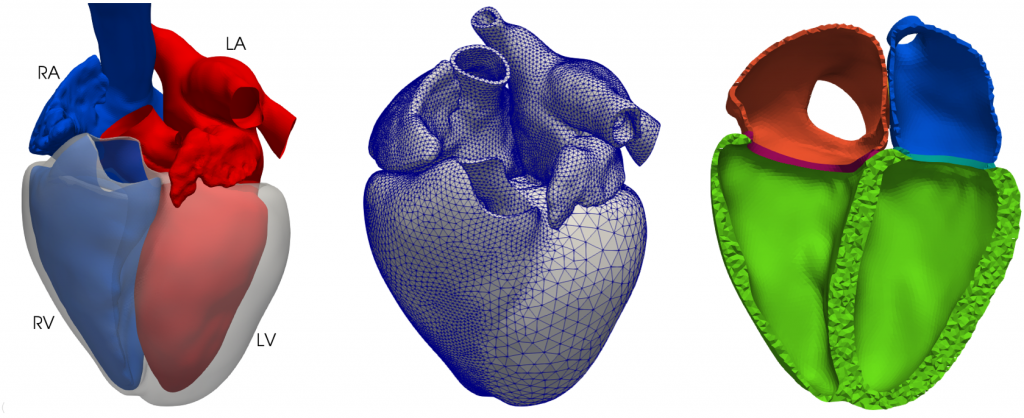
However, building a simulator for a biological system such as the heart is an extremely ambitious goal, for many reasons. First and foremost because of the sheer complexity of the object in question – the heart – the functioning of which is the result of processes of different natures (biochemical, electrical, mechanical, fluid dynamic), all of which act in a coordinated way to pump blood throughout the body, and all linked together by a complex yet fascinating network of interactions and retroactions. Aside from this, there is also an intrinsic difficulty due to our incomplete knowledge of this complex system. If we want to develop a simulator of an industrial process, for example, we are able to accurately describe all of its components, as they were originally designed by man. The heart, on the other hand, was not designed by man, and that makes it particularly difficult to formulate accurate mathematical models.
Finally, the iHEART project presents some truly massive computational challenges. Indeed, a model of the heart can contain several million (and often even several billion) variables, all of which are required to represent the organ with a sufficient level of detail. The search for a numerical solution can only be carried out using supercomputers, and the simulation of just a single heartbeat can involve several days of calculation.
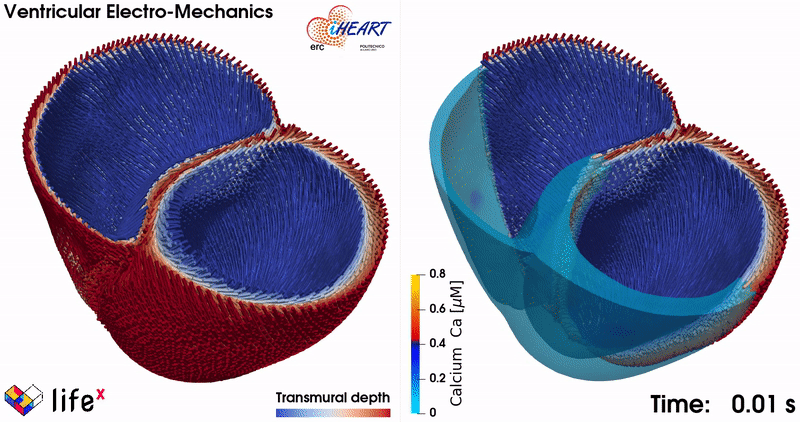
And more specifically, what is your personal role in this project?
My role in this project is to work on the electromechanical aspects, in other words the sub-cellular mechanisms by which, following an electrical stimulus, the cells of the heart contract and generate the necessary force to open the heart’s valves and pump blood to the rest of the body. More specifically, during my PhD I developed a model that explains how cardiac cells are able to generate the force required to make the heart contract in response to various external stimuli. Thanks to innovative mathematical techniques, I was able to translate the complex interactions between the proteins that cause our hearts to beat into equations, thereby making it possible – for the first time – to simulate the contraction of a cardiac cell in only a few seconds, all without having to sacrifice a detailed description of the physical processes taking place. This small step opened up incredible new possibilities in the study of conditions arising from alterations in contractile mechanisms, such as hypertrophic cardiomyopathy, a serious disease that affects one in every 500 people. This model, when properly combined with further equations capable of describing other physical processes, can also be used to simulate the heart as a whole.
In the context of iHEART, I also deal with what is known as ‘model order reduction’. This term refers to a set of techniques aimed at speeding up the retrieval of a solution for a highly complex model. Specifically, we are studying the use of artificial intelligence (and Machine Learning in particular) to build reduced models based on the results of simulations previously carried out with the original models. The ultimate goal here is to construct a tool capable of providing answers – albeit approximate ones – in a very short space of time, thus facilitating the use of the cardiac model developed under iHEART in clinical settings.
Why could iHEART become important for the lives of ordinary people? And what are the next frontiers along the way on your research path?
The model of the heart that we are developing could one day become a tool in the hands of cardiologists and heart surgeons. By using the biometric data and diagnostic tests of a specific patient, the virtual heart developed in the iHEART project could be personalised, effectively creating a ‘digital twin’ of the patient’s heart. The doctor could then use this virtual replica to explore different treatment options or surgical strategies, tailored specifically to the individual patient, simply by interacting with the computer – and all before treating the actual patient. Secondly, the model could assist doctors in interpreting the results of diagnostic tests, giving them the opportunity to replace invasive methods of measurement with indirect, less invasive ones.
The model could also be used for medical research purposes. Indeed, it makes it possible to run scenario analyses, study the interactions between the different components of the organ, or simulate the effects of diseases or innovative treatments by applying them – entirely virtually – to the digital heart.
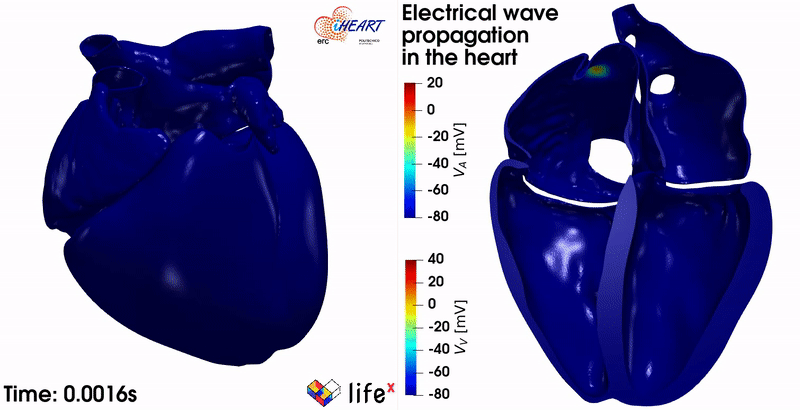
Who is your team made up of and how do you organise the work between you?
Our team consists of about twenty people, all with a background in Mathematics or Engineering (Mathematical, Biomedical or Aerospace Engineering), from the youngest (PhD students) to the most senior (professors). We also have various collaborators on board, both medical staff and researchers from research groups working on similar issues to us. The project leader is Prof. Alfio Quarteroni, who was also my supervisor for my doctoral thesis.
Each member of the team brings something different to the table: some focus on methodological aspects (research into numerical methods, software development, processing of clinical data, etc.), whilst others concentrate on a specific field of application (electrophysiology, mechanics, fluid dynamics). However, we all have to be able to master each of these aspects to some extent. That, in my opinion, is the really beautiful thing about our work: a project like iHEART involves such a broad spectrum of interconnected subject areas. This presents us with different challenges every day, requiring solid collaboration between the members of the working group on a daily basis. Teamwork is paramount in our area of research.
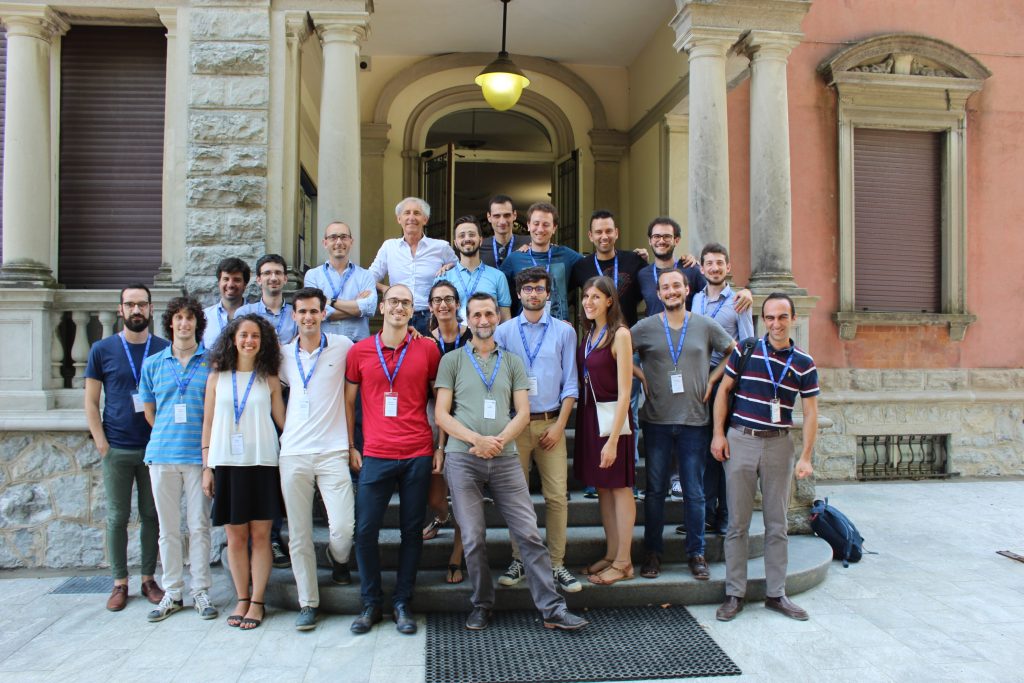
What was the spark that set you off down the path of becoming a researcher? Do you remember an exact moment in particular when you realised that this was your calling in life?
My passion for research started when I was developing my master’s thesis in the field of 3D printing and innovative self-assembling materials. Although I later changed to a completely different area of application, moving to the biomedical field, working on my thesis was an opportunity for me to fall in love with research in the field of applied mathematics. But the deepest roots of this interest may in fact go back much further: experimenting and inventing have always been passions of mine. During my university studies, I was more drawn to the aspects connected more to do with pure mathematics, but later on I realised how fascinating it can be to apply these mathematical tools to the real world. I firmly believe that the perfect and ultimate implementation of a mathematical theory, however abstract it may be, is using it to find solutions to previously unsolved problems, and the biomedical field not only provides problems which it can be in the public interest to solve, but also offers boundless inspiration from this point of view. Overall, this is something that I find incredibly appealing, and it provides me with constant motivation through the toughest times.
What does your academic career thus far look like?
I graduated with a degree in Mathematical Engineering at the Politecnico di Milano, where I started a PhD course within the MOX, the Laboratory for Modelling and Scientific Computing. From the very start of my PhD, I worked in the field of cardiac modelling, under the guidance of Profs. Alfio Quarteroni and Luca Dede’. Over the course of those years, I was able to travel a great deal, coming into contact with other researchers, which allowed me to discover different perspectives and working methods than I was used to. In particular, I spent two research periods lasting several months each at INRIA in Paris and Pennsylvania State University. I then continued my career with a research fellowship at the Politecnico, where I recently earned a position as a researcher.
You won a VPH2020 Virtual Physiological Human prize awarded to the best presentations by up-and-coming researchers. How can a researcher most effectively communicate their research nowadays? Simply put, how do you explain to your friends what you do every day?
Managing to clearly explain what your research is about – and more importantly, why it can have an impact on the wider community – is as difficult as it is important. A researcher has to put themselves in the shoes of the people they are speaking to, make the effort to use suitable terminology, and try not to take for granted a knowledge of the concepts that are part of the cultural background of the community to which the researcher belongs. Personally, I feel that this is also a useful exercise for the researcher themselves. After all, as Albert Einstein used to say, “If you can’t explain it simply, you don’t understand it well enough”.
This has all become a great deal more difficult these days, on the one hand because of the increasingly specialised nature of the research, and on the other because of the often sceptical common feeling towards science. Whilst admittedly, there are now social media channels that allow researchers to address a potentially very wide audience, only a small fraction of researchers actively dedicate themselves to the dissemination of their research (the so-called ‘third mission’). Our research group has a website and a YouTube channel on which we regularly post material specifically to communicate our research in an approachable way. I have also personally participated in Meet Me Tonight, a wonderful initiative involving several universities in Milan dedicated to fostering interaction between researchers and citizens, both adults and children, though with a special focus on the latter.
From your experience working on the iHEART project, what skills do you think one needs to participate in an international research project?
First of all, you need a huge amount of passion for your field of research. You will inevitably come up against difficult moments – moments when what you are developing isn’t working, when you are struggling to see solutions to the problems that arise. These are actually the very heart of research. As such, without a strong sense of motivation, it is very difficult to move forward and you will often be tempted to give up entirely, with all your efforts thus far amounting to nothing. I also think that it’s essential to feel that you are part of a group. Scientific research has now reached the level at which cooperation is absolutely indispensable. I feel very lucky to be part of the research group that I work in, where I have found not just colleagues, but also some good friends. Finally, I think that a key aspect of any researcher’s mentality should be always questioning yourself, continually re-examining whether your approach to problems is the only one possible or whether better alternatives might exist.
What would you say to a young person of your age who is undecided about whether or not to try out a career in the world of research? Have you also experienced moments of indecision? How can you get past them?
To a young person who is still undecided, I would say that you should only venture into research if you are highly motivated. Something I often say to students who ask me “can I do a PhD if I don’t have very high grades?” is that you don’t need to be top of your class to be able to do good scientific research. At the risk of repeating myself, the essential requirement is a great deal of passion and plenty of curiosity. If that applies to you, then research is a path that I would warmly recommend from the bottom of my heart, as it can give you a huge amount of satisfaction.
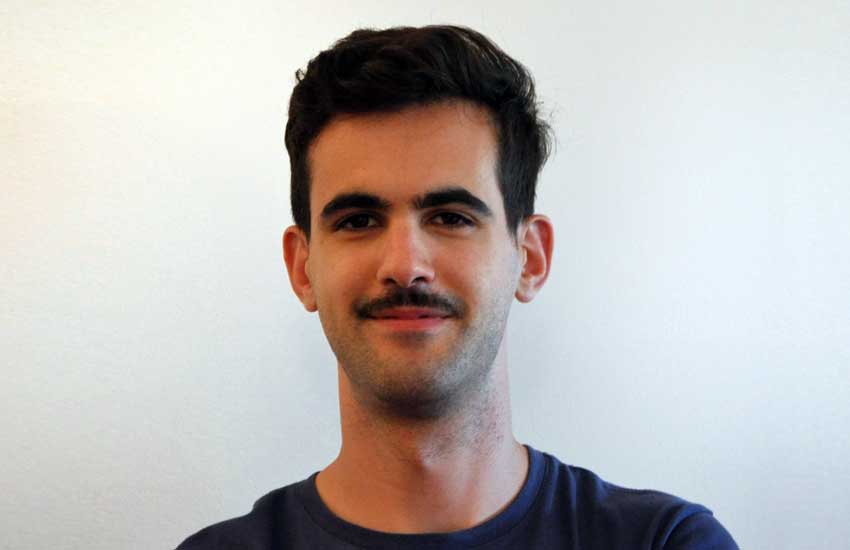
Francesco Regazzoni is a research fellow at the MOX – Modellistica e Calcolo Scientifico (Modelling and Scientific Calculation) lab, where he works on the H2020 iHEART project under the guidance of professor Alfio Quarteroni.
He holds a PhD in Mathematical Models and Methods in Engineering, with a thesis presented at Polimi entitled “Mathematical Modelling and Machine Learning for the Numerical Simulation of Cardiac Electromechanics”, which won the prestigious GBMA-AIMETA PhD Award 2020. The prize was awarded by AIMETA (Italian Association of Theoretical and Applied Mechanics, Biomechanics Group – GBMA) for the Best PhD Thesis in Theoretical and Applied Biomechanics.
